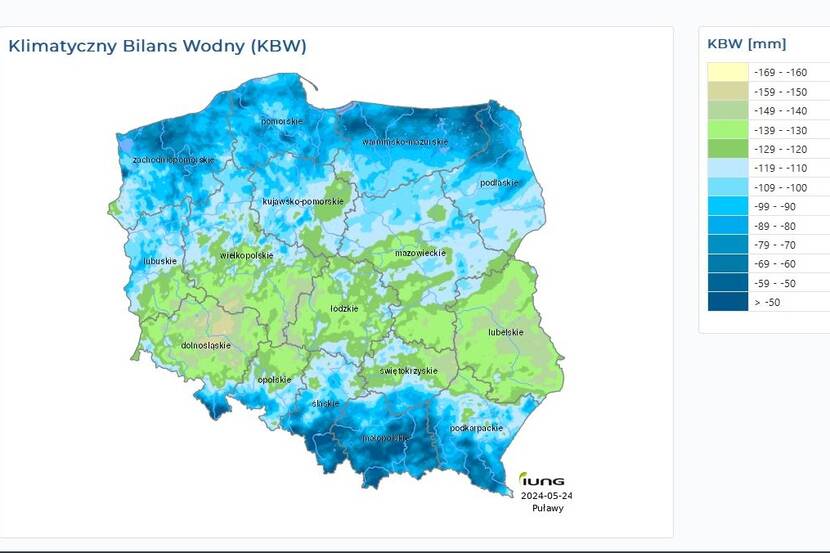Drought in Poland
Data from the Institute of Cultivation and Fertilization in Puławy confirm what farmers have been observing for about three weeks. Drought in Poland is getting worse. The only thing that can help is a powerful, deep low and several hours of rain.
Today, Poland is one of the countries with the poorest water resources. This includes: the result of almost snowless winters, less rainfall and the lack of an appropriate retention system. The result is that drought now covers almost the entire country.

According to data presented by the Institute, in the first reporting period, i.e. from March 21 to May 20, 2024, the average value of the Climatic Water Balance (KBW) for Poland was negative and amounted to -92 mm. For comparison: last year, in the same period, the mentioned value was - 29 mm (then no drought was recorded in the country in the mentioned period).

The greatest water shortages
In the rest of Poland, water shortages amounted to -60 to -119 mm. Therefore, agricultural drought was recorded in 14 out of 16 voivodeships in Poland.
To sum up, drought in Poland in May 2024 is the result of negligible rainfall, which in the first decade of May did not exceed 5 mm in most of the country. The situation "improved" slightly in the second decade of the month. Namely, in most of Poland, rainfall ranged from 5 to 15 mm. This amount of rainfall is not enough to meet the water needs of crops. In particular, very high temperatures and wind quickly dry out the soil.
Drought in spring cereals affected 14 voivodeships, of which in three of them the share of communes with recorded drought exceeded 80%.
- Lubuskie (199 communes, 93.43%),
- Łódzkie (159 communes, 89.83%)
- Dolnośląskie (144 communes/85.21%).
Drought in Poland affects winter cereals in 12 voivodeships, with the greatest impact in the voivodeship
- Lubelskie (195 communes/91.55%)
- Dolnośląskie (138 communes/81.66%)
- Łódzkie (129 communes/72.88%).
When it comes to strawberry cultivation, the worst situation is in the voivodeship
- Lubelskie, where it covered 185 communes (86.85%).
- Dolnośląskie, where 121 communes were affected (71.60%)
- Wielkopolskie (110 communes/48.67%).

Orchards
In the case of fruit bushes, the largest number of communes with drought are in the Lower Silesian Voivodeship (30) (17.75% of the voivodeship's communes). In the Greater Poland Voivodeship, 14 communes (6.19%) suffer from drought, and in the Świętokrzyskie Voivodeship, which ranks third, 2 communes (1.96%) suffer from drought.
Fruit growers see drought with the naked eye. The earth is as hard as a rock, and where there is no irrigation, water shortages are already visible on the plants. Therefore, practically throughout May, irrigation systems in orchards work at full speed. There are places in the Grójec region (main orchard region of Poland) where there have been no storms in recent days, and the total rainfall in May was only 2 - 5 liters of water per square meter.
Storms, even intense ones that bring several dozen liters of water per square meter, do not improve the overall hydrological situation in Poland. For a few days, they only improve the vigor of plants locally, because most of the water flows over dry and hard ground. In the current situation, farmers are looking for long and steady rainfall that will come with a deep low.
Future
What will be the effects of the current drought in agriculture? Zbigniew Karaczun from Warsaw Univeristy of Life Sciences has no doubt that farmers are facing a huge change. They will have to, among other things: give up many traditional crops. The list of vegetables they will probably have to give up due to drought includes potatoes.
Farmers will have to switch to growing plants that are resistant to high temperatures and require less water. Another issue is changing cultivation techniques. The main goal is to increase water retention in the soil. A way to retain water may be, for example, the use of organic and natural fertilizers, says prof Karaczun.
Source: IUNG / Money.pl/ Wp.pl / Sad24.pl / wieści rolnicze / agrofakt.pl